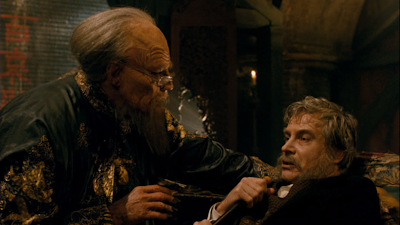In the 2011 film, Sherlock Holmes: A Game of Shadows, Professor James Moriarty signs copies of The Dynamics of an Asteroid in Paris. His signature is an elegant scrawl from a fountain pen as he speaks in effortless French to those who have come to praise him. A man in an inconspicuous tweed suit slides into the empty seat next the Professor, a pair of opera tickets in his hands. There is a long pause as he waits for Moriarty to address him. Finally, the Professor turns, only slightly, to look at the man at his side: “My ticket?” The man nods, gesturing with the object in question. “Unfortunately,” the Professor says, “you won’t be needing yours.” The man’s expression is largely unreadable as he looks back down at the tickets in his hands, but his sardonic tone is telling: “It’s a shame, Professor. I was looking forward to Don Giovanni.” The identity of the man in the unprepossessing suit isn’t officially revealed as Colonel Sebastian Moran until a bit later in the film, but there are enough clues in even that brief scene for the viewer to make the logical deduction on his or her own. For is that not how we always picture Colonel Moran – the slightly uncouth man on Moriarty’s right hand?
 |
| Paul Anderson as Colonel Sebastian Moran and Jared Harris as Professor James Moriarty |
 |
| Jeremy Brett as Sherlock Holmes and Patrick Allen as Colonel Moran |
At the end of EMPT, the Great Detective seems more than confident that the Colonel will no longer be a concern, but Moran doesn’t disappear from the Canon entirely. In “The Illustrious Client,” which according to William Baring-Gould’s chronology takes place in 1902, Holmes comments: “If your man is more dangerous than the late Professor Moriarty, or than the living Colonel Sebastian Moran, then he is indeed worth meeting.” And in “His Last Bow,” which according to the same chronology takes place in 1914: “The old sweet song… How often have I heard it in days gone by! It was a favourite ditty of the late lamented Professor Moriarty. Colonel Sebastian Moran has also been known to warble it.” This means that Moran was most definitely alive as of 1902, and most probably alive as of 1914 (Holmes refers to the Colonel in the present tense, but a life of international espionage is a busy one, so it might be worth arguing that Holmes’s information could be outdated). Surviving an incarceration of twenty years or more certainly shows a certain resilience of character, or perhaps just a mulish intractability.
At the end of A Game of Shadows, Moran covertly executes Professor Moriarty’s undercover assassin (discreetly, with a blowgun) and then walks out of the Swiss chateau, into the shadows, and away from Professor Moriarty, who is currently engaged in a cerebral battle out on the balcony with Sherlock Holmes. Dr. Watson runs towards his friend, while the Colonel just simply walks away, his intended direction unknown. It is a curious divergence, but not entirely unexpected. As Holmes himself points out in EMPT:
"There are some trees, Watson, which grow to a certain height, and then suddenly develop some unsightly eccentricity. You will see it often in humans. I have a theory that the individual represents in his development the whole procession of his ancestors, and that such a sudden turn to good or evil stands for some strong influence which came into the line of his pedigree. The person becomes, as it were, the epitome of the history of his own family... Whatever the cause, Colonel Moran began to go wrong."
The Great Detective refers to Colonel Moran as a shikari, which is a Persian word in two parts: the main “Shikar,” meaning “of hunting” and the suffix “i” denoting possession. And it would seem that Moran too was a character in two parts. He comprises a certain cold reservation that made him equal to sit beside Professor Moriarty, but also a contrary savagery that made him effective in his role. Like so many remarkable characters, it is the dichotomy that makes Moran interesting, makes him memorable. Sherlockians return to Colonel Sebastian Moran not simply because he sits beside Professor Moriarty, but because he stands on his own, and cuts his own path.
oOo
“Better Holmes & Gardens” now has its own Facebook page. Join by “Liking” the page here, and receive all the latest updates, news, and Sherlockian tidbits.





